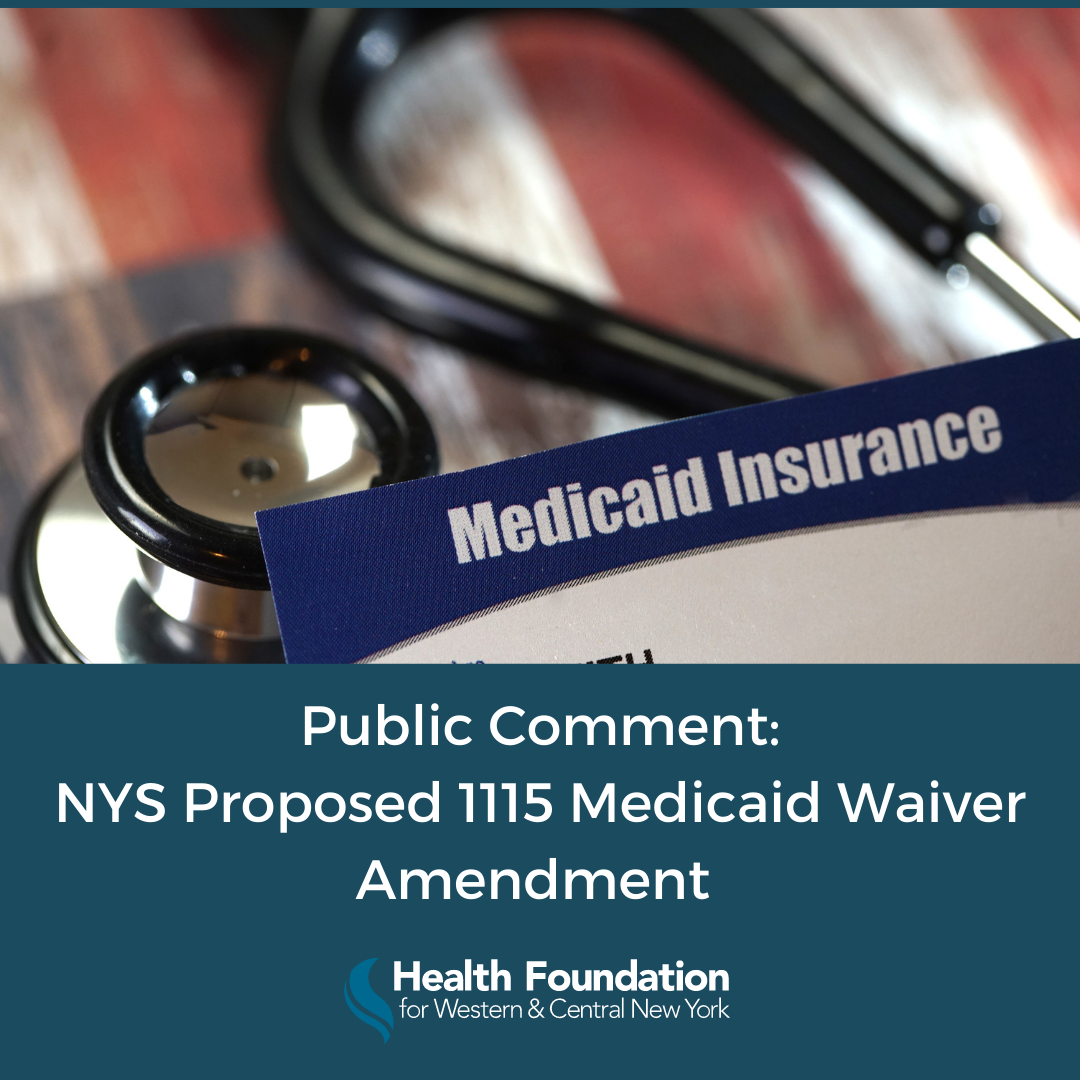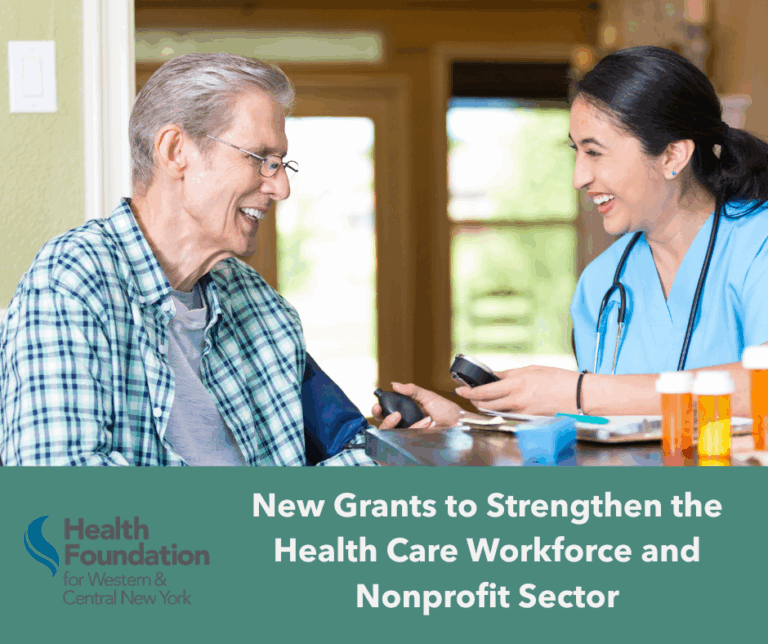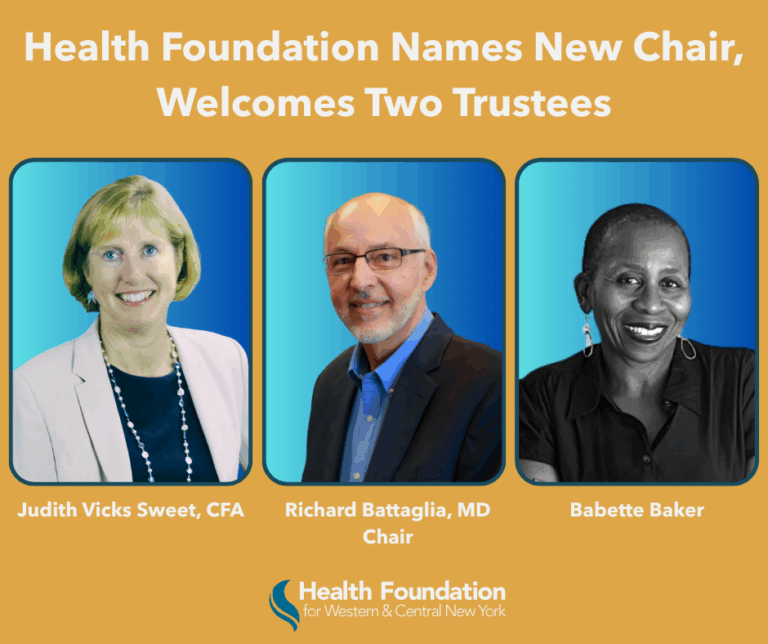The New York 1115 Medicaid Waiver is an agreement between the Federal Centers for Medicare and Medicaid Services (CMS) and New York State that allows the State to administer Medicaid Managed Care. The following public comments in response to the state’s proposed amendment to the waiver entitled “Strategic Health Equity Reform Payment Arrangements: Making Targeted, Evidence-Based Investments to Address the Health Disparities Exacerbated by the COVID-19 Pandemic.” The proposal was released and opened for public comments in April 2022. Learn more here.
The Health Foundation for Western & Central New York appreciates the opportunity to contribute public comments on the proposed 1115 Medicaid Waiver. As a grantmaking organization dedicated to advancing racial and socioeconomic health equity in western and central New York, there are many aspects of the proposal that are relevant to our work and the work of our grantees and partners.
Overall, we support and appreciate the focus on health equity throughout this proposal. There are many included initiatives that, when implemented, can lead to a stronger public-private network of service providers working to improve the health of our community and address health disparities.
As this work moves forward, we urge New York State to build on existing, established infrastructure whenever possible, rely on trusted messengers who are already working in these communities, and prioritize the needs and voices of community members and those who work closest to them. That approach is in line with current standards and best practices in pursuing racial health equity.
On Health Equity Regional Organizations (HEROs):
- We echo Medicaid Matters in urging leadership to specifically include consumers, consumer advocates, and community members in the development and implementation of HEROs. In order for this to be a fair and inclusive process, a wide variety of stakeholders must be ‘at the table.’
- While we understand the need to include Managed Care Organizations in HEROs, it is imperative that stakeholders from across the community, especially those who work closely with consumers and community members, have a strong and influential voice in this work. Previous similar initiatives resulted in MCOs and health systems having outsized influence on strategy and decision-making. We strongly urge the state to consider how to create and implement a structure for HEROs that enables social care providers to be considered equal partners in this work.
- Including a variety of stakeholders in these discussions will also help ensure care is delivered in a fair and equitable way. A recent study from the U.S. Department of Health and Human Services found that many Medicare Advantage plans (administered by MCOs) are frequently denying necessary, important care to older adults across the country. Having a balanced, diverse set of voices contributing to HEROs will help ensure people receive the care they need.
- In particular, Federally Qualified Health Centers (FQHCs) and other community health centers should have a significant role in HERO governance, as they are close to care delivery, are viewed as trusted messengers, and have a deep understanding of community needs.
- Any health equity planning should be developed in alignment with best practices in racial and socioeconomic health equity, such as root cause analyses and back-mapping on collected information to more specifically identify system-level drivers of health disparities.
- We support the comments of Jamie Saunders of United Way of Greater Rochester and the Finger Lakes and others who have urged the state to reconsider the requirement for evidence-based services to include evidence informed and promising practices. “Evidence-based” is a gold standard hurdle very few community organizations can overcome, is costly, limits innovation, and is counter to the stated equity goals by narrowing the partner set to only the largest providers.
On Data Collection Systems and a Statewide Database
- All data collection efforts should leverage existing infrastructure across the state and not build new data collection systems from scratch.
- Similarly, we urge those leading data collection efforts to prioritize disaggregating data as this is considered a best practice in racial health equity initiatives and will paint a clearer picture of the health needs of specific racial and ethnic groups. For example, mothers of Puerto Rican descent experience high rates of maternal mortality. Refined data analysis that examines this population specifically can more effectively determine root causes of this disparity.
- We echo those who have asked the state to reconsider the requirement of a single statewide database, and other prescriptive elements as outlined in the waiver, and rather to focus on defining the overall goals and objectives of this data collection, allowing communities to leverage data platforms already in place with a focus on interoperability and planning for future needs.
- We echo Kelly Dodd of the United Way of New York State, serving as the Director of 211 NY, who states “211 believes that rather than the state prescribing a statewide I&R platform which would supplant existing 211 infrastructure, as well as tech infrastructure in other social care networks, the state should look to create a community information exchange linked to 211 similar to what has been done in San Diego, recognizing that interoperability across platforms should be the goal, rather than a single tool forced upon all.”
- We echo the comments of Area Agencies on Aging regarding building on Aging and Disability Resource Centers (NY Connects) which maintains a statewide resource directory, similar to 211, and is already collecting valuable information on aging and disabled populations.
On Social Determinant of Health Networks
- We urge the state to leverage the work happening at the federal level (including Center for Medicare and Medicaid Services and Administration for Community Living) to develop “community integrated health networks” such as the WNY Integrated Care Collaborative. There has been significant federal investments in these areas, and the state has the opportunity to learn from these expansive efforts and build on them.
- We agree with the WNY Integrated Care Collaborative’s comment that the state should require that SDHN awardees have past experience serving their target regions, and have a governance structure that is representative of the organizations in the network. We support WNYICC’s comment requesting that community-based organizations be able to participate in more than one network if they are serving multiple state regions.
On Behavioral Health
- We echo SNAPCAP and others that note there is a large focus around behavioral health organizations in the proposal. However, FQHCs also provide behavioral health services at many of their health centers and in the rural areas their health centers are the largest provider of behavior health services. We urge the state to consider inclusion and focus on other providers of behavioral health services outside of standalone behavioral health systems.
On Institutionalized Populations
- We support the inclusion of incentives to deter or avoid nursing home placements.
- The nursing home diversion program requires people to have been in nursing homes for at least 90 days. This can be extremely disruptive to the person, their finances, their family caregivers, and the facility. Instead, we urge leadership to prioritize preventing unnecessary nursing home placements.
- We recommend reviewing lessons learned under the Balancing Incentive Program and its Innovation Fund. Programs such as Ready, Set, Home yielded significant return on investment and reached a significant number of people of color.
- The state must distinguish the “master plan” for long term services and supports mentioned in application from the Master Plan for Aging, which is intended to be an over-arching, cross-sector plan for prioritizing healthy aging in all areas.
On Telehealth
- The proposal indicates there will be funding for two community health workers per county to do telehealth training. This is woefully insufficient, especially considering the growing need for telehealth services that resulted from the pandemic. Please consider increasing the resources devoted to this important aspect of the proposal.
On Other Health Equity Efforts
- The outlined workforce investments related to health equity mention expanding the number of community health workers, care navigators, and peer support workers. We recommend including doulas in this effort as well, and enhancing the ability of/incentives for doulas to serve patients enrolled in Medicaid. Having doula care access is strongly linked to reductions in maternal morbidity and mortality.
- To increase access to doula services for low-income populations, these services should be reimbursable across the state and reimbursement rates for doula services should be commensurate with pay rates for private doulas.
- We support recommended efforts to allow incarcerated people to begin enrolling in Medicaid 30 days before release, helping to close inevitable gaps in coverage that result in the current system, which only allows enrollment after release.
- Additionally, we support efforts to ensure care coordinators are located in the regions where formerly incarcerated people live after release, versus where the prison is located. However, this requires strengthening the current infrastructure of internet access for people in prison so they may access telehealth services to connect with their care coordinator.
- We encourage the state to reconsider their decision to start efforts on criminal justice-involved populations with those transitioning out of state prisons, and instead begin that work with those in county jails. Successful pilots are already underway in county jails and can provide early data and lessons to support this effort.



